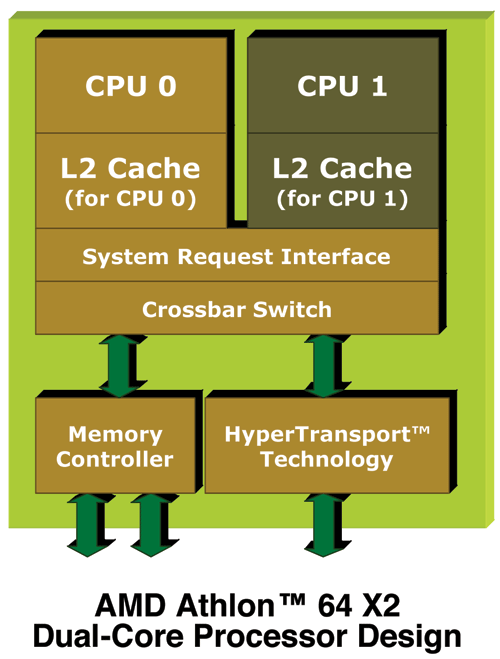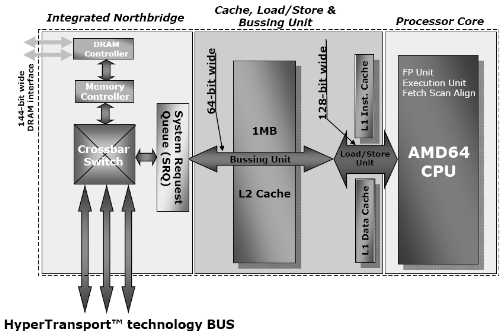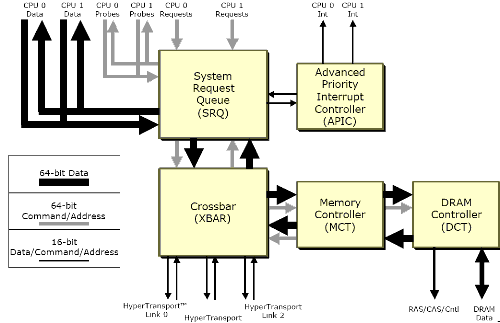The Quest for More Processing Power, Part Three: "Multi core of Intel and AMD compared"
by Johan De Gelas on May 18, 2005 3:15 PM EST- Posted in
- CPUs
Dual core Opteron versus Pentium-D and Dempsey
There is no doubt that the Dual core Opteron architecture is more advanced and elegant than the Pentium-D and even future Netburst based dual cores such as Dempsey (Xeon). The Pentium-D Dual core is more a way of packaging than an actual architecture: two cores cut out the wafer together, and communicate via an external FSB.With two different L1 and L2-caches, and two CPUs working on the same variables, you risk that one of the CPUs is working on an outdated cached value. You need to make sure that if variable A is cached on both CPUs, and CPU 1 changes the value of variable A, then CPU 2 knows about it. This happens with a protocol called MESI on the Intel CPUs and MOESI on the AMD CPUs. The discussion of these “cache coherency protocols” is outside the scope of this article, but you understand that the more variables that are shared between the two CPUs, the more communication that will happen between the caches of the different CPUs.
In the case of the Pentium-D, the caches talk to each other (to keep cache consistency) via a shared 800 MHz bus, just like two single core SMP Xeons. Not only is 800 MHz relatively slow compared to the CPU (3200 MHz), but exchanging information via a bus also increases latency and lowers bandwidth. Latency is increased as the bus may not always be free - one of the CPUs might be using it to transfer data to or from the memory. This half duplex bus can only transmit signals of one device (CPU 1, CPU 2, chipset) at a given moment. Bandwidth is decreased as the cache coherency exchanges need a small amount of time on the bus too.
Enter the elegant dual core Opteron architecture. Each core in the Dual Opteron/Athlon 64 X2 puts its request on the System Request Queue (SRQ).













28 Comments
View All Comments
nserra - Thursday, May 19, 2005 - link
The previous post was for the biased person who wrote this article. Johan De Gelas^
|Just kiding ;)
nserra - Thursday, May 19, 2005 - link
"AMDs current dual core architecture is vastly superior to Intels"This is wrong!!! You said your self that Intel "new" processor was more of a “special” packing than a dual core processor, so you should say is:
"AMDs current dual core architecture is amazing let’s wait what intel will do at a latter time"
TDP is for power consuming as a 500W PSU is at it. Just because you have 500W PSU doesn’t mean it draws 500W of power.
New Venice core as more transistors than the previous core not just because of SSE3, there is new power stages than can be enable to further lower power consuming, I doubt that putting a Turion on a regular board will enable those new power stages.
Viditor - Thursday, May 19, 2005 - link
G'day Jarred!"the Pentium M 2.0 GHz chips manage to run at 22W"
To be specific, they have a TDP of 22 watts which isn't really the same thing...
"as I understand it even under maximum load the Pentium M stays under 22W, right?"
Not at all...in fact it can be significantly higher than that. Intel's TDP measures an average usage under load rather than peak, while AMD's measures absolute theoretical peak under the worst conditions. This is why the TDP is quite meaningless...
I guess my point is that I am of the opinion that the Turion might actually run at significantly lower power usages. As absolutely nobody (that I am aware of) has tested beyond the system level (i.e. the chip itself), I can't be sure...but judging by the actual specs of the chips themselves (not the TDP, but the electrical specifications) it appears that the PM may indeed be higher.
I know I've asked before, but with the power usage and heat becoming more and more important, couldn't you guys develop a test of the actual realworld usage of the chips themselves?
I think it might be quite illuminating...
Cheers!
4lpha0ne - Thursday, May 19, 2005 - link
@Questar:Criticizing Intel and saying good things about AMD and IBM means, that Johan is an AMD fanboy? I think not. You'll see, that the opinions about Whitefield, Merom, Yonah & Co. after hitting the public will be better than about Smithfield now. That's simply the result of the amount of effort put into the designs. A dedicated dual core design is not the same as an on die dual Xeon system.
@photoguy99:
I'd say, Johan can make this conclusion, because he has the knowledge to do so. I'd come to the same conclusion, since the Windows scheduler (at least for XP) is not so much core-aware. It just sees the logical or phyisical CPUs and if one becomes free, it just sends the next thread to it. This causes thread-hopping (can be seen in the tech-report dual core reviews thanks to task manager screenshots). In such cases it matters somewhat if the last used data is in the other L2 cache and can be quickly transferred to the current L2 cache. And it matters for multithreaded applications, which work on the same set of data.
@mazuz:
I'd suggest to look at benchmarks of a 275 vs. dual 248 with 1 dual channel memory bank and benchmarks of a dual Xeon with FSB800 and a similarly configured (cache, FSB, memory, HT) Smithfield. That's the difference caused by the SRQ-connection.
@Ahkorishaan:
The mentioned upcoming Intel cores will indeed be nice. But some people here and on many other forums sound like the dual core K8 was AMD's last CPU and the K8 their last core ever. :) However, have a look at AMD's patent portfolio and you'll see, that this is not the case. As Fred Weber said, AMD is also still looking at power consumption. This is maybe the reason, why we might see a future CPU with more cores, but less FPU power per core (due to shared FPUs).
AMD is also working on using things like clock gating and throttling (used by P-M) to further reduce power consumption. Currently they only implemented some standard features to keep power consumption down like other transistor designs (especially slower transistors in not so critical places), microarchitectural changes (better HALT mode), C3 state and PowerNow!/C'n'Q.
Matthias
JarredWalton - Wednesday, May 18, 2005 - link
Viditor, I think the point is that the Pentium M 2.0 GHz chips manage to run at 22W - still less than 1/3 of what the Winchester and Venice cores put out, I think. What exactly did they do to get that low? Well, there's gating technology for sure - i.e. power down unused portions of the chip - but as I understand it even under maximum load the Pentium M stays under 22W, right?Maybe Johan has more specifics, but I don't. I just know the price for power use on the design is very impressive, and I was surprised some of the same tech wasn't used in Prescott.
Viditor - Wednesday, May 18, 2005 - link
Your usual excellent work Johan, thanks.A couple of nits to pick...
"Intel will use its P-m “know-how” to keep the power dissipation so low"
If you could qualify exactly what "know-how" you mean, that would be appreciated. IMHO, a major reason that PM is able to stay so much cooler that the Netburst chips (and on par with the Athlons) is that it doesn't have nearly as many features... Is there a reason you see the PM translating well into full blown server and desktop chips?
"Intel can leverage their experience with the power saving features of the P-m to design quad core CPUs with remarkably low TDP"
Arrrrrggghhh! This is a pet peave of mine. TDP IS NOT POWER USAGE!!! Sorry, I know you know this, but most don't and it's been quite frustrating.
For those who don't know, TDP is an arbitrary design spec for OEMs to use with the CPU...
AMD's TDP is so much higher than Intel's relative to actual power usage because AMD is much more cautious in it's design spec, not because it uses that much power.
As to Questar's comments, IMHO the fact that the worst thing he can say is a short unsubstantiated rant speaks volumes to the credibility of the article.
Thanks again Johan!
phaxmohdem - Wednesday, May 18, 2005 - link
You are all fools. IDT's Winchip X2 dual core solution will blow all of this crapolla out of the warer.mazuz - Wednesday, May 18, 2005 - link
"AMDs current dual core architecture is vastly superior to Intels"This seems like a pretty strong statement considering there doesn't seem to be any known real world advantage to this architecture.
photoguy99 - Wednesday, May 18, 2005 - link
Johan, isn't this statement a little unfounded:"we can be pretty sure that there are applications out there that do benefit from very fast cache-to-cache transfers"
How can you be pretty sure when you've cited none? I know you said you'll do more testing - but *after* that testing is done seems like the time to be "pretty sure" it's a real world benefit.
You've written a good article, it was informative. Just prefer conservative research conclusions.
bob661 - Wednesday, May 18, 2005 - link
#7Who cares which company is ahead or behind? I sure as hell don't. Give me good bang for the buck. That's all I want.